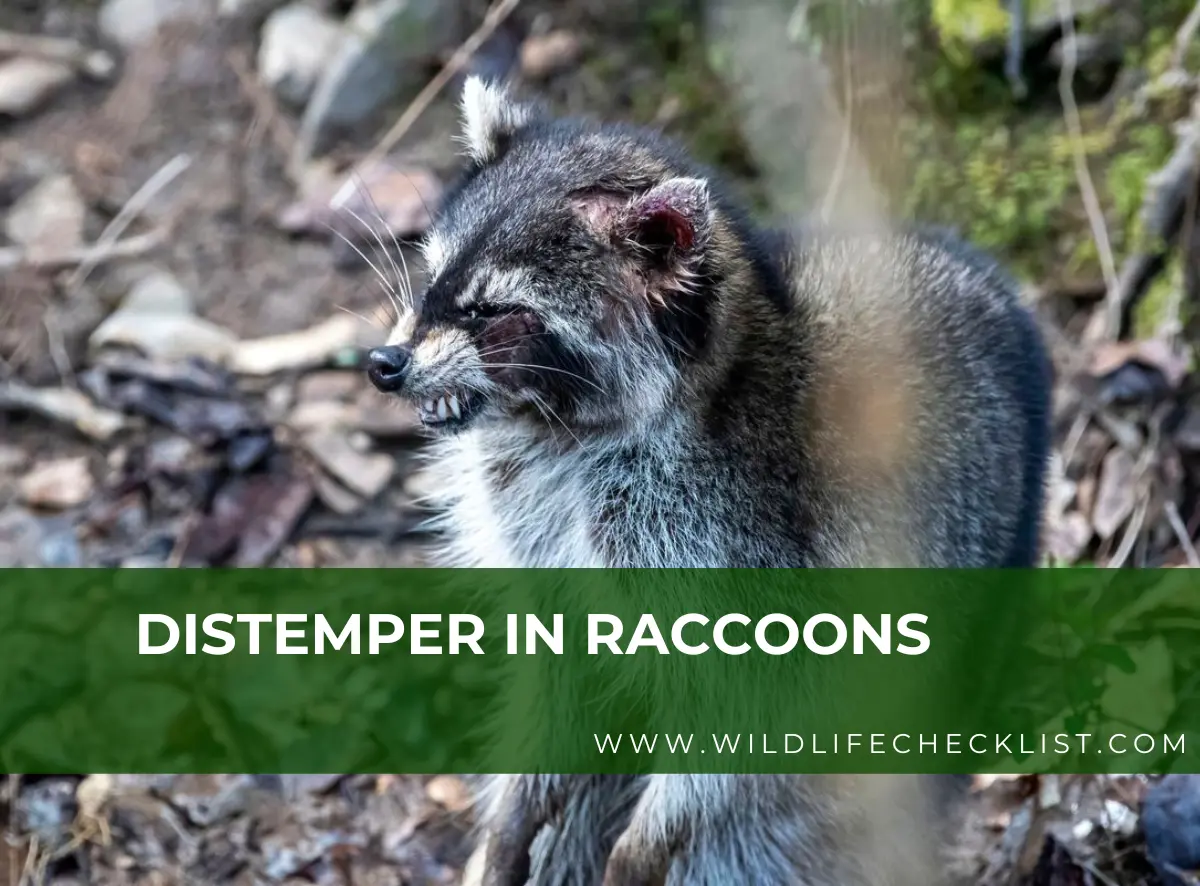Distemper In Raccoons (Symptoms, Effects, Prevention and Treatments)

Raccoons are fascinating creatures known for their mischievous behavior and adaptability to various environments. However, these intelligent mammals are not immune to diseases that can significantly impact their population. One such disease is distemper in raccoons. A viral illness that poses a threat to their health and well-being.
In this article, we will explore the topic of distemper in raccoons, including its causes, symptoms, transmission, and implications for both raccoon populations and human interaction.
Understanding distemper in raccoons is essential for promoting wildlife health and minimizing the risks of transmission to humans and other animals.
By exploring the causes, symptoms, transmission, and implications of distemper, we can gain insights into how to prevent the spread of this viral disease and protect both raccoon populations and human well-being.
Contents
What is Distemper?
Distemper is a highly contagious viral disease caused by the canine distemper virus (CDV). It primarily affects carnivores, including raccoons, and is closely related to the measles virus in humans.
Distemper weakens the immune system, making raccoons more susceptible to secondary infections and reducing their overall health and physical condition. In severe cases, distemper can be fatal for raccoons.
The implications of distemper extend beyond individual raccoons. Outbreaks of the disease can cause significant mortality, particularly among younger raccoons with weaker immune systems.
Distemper spreads rapidly within raccoon populations, leading to a decline in population numbers. Infected raccoons may display abnormal behaviors, posing risks to other wildlife, pets, and humans.
What Causes Distemper In Raccoons
Distemper in raccoons is caused by a virus known as the Canine Distemper Virus (CDV). Despite its name, this virus can infect a wide range of animals, including raccoons, domestic dogs, foxes, wolves, and other wildlife species.
The virus is highly contagious and primarily spreads through respiratory secretions or direct contact with infected animals. Infected raccoons shed the virus in their saliva, urine, and feces, contributing to its transmission.
Once the virus enters a raccoon’s body, it targets the respiratory and nervous systems, leading to a variety of symptoms, including respiratory signs, neurological issues, and gastrointestinal disturbances.
Distemper is a serious disease with no specific treatment, and prevention through vaccination is essential for domestic dogs and some wildlife species.
How Do Raccoons Get Distemper?
Raccoons get distemper through close contact with infected animals, primarily via respiratory secretions, such as sneezing and coughing. The virus can also spread through contact with contaminated surfaces or objects.
Infected raccoons shed the virus in their saliva, urine, and feces, facilitating transmission to other susceptible individuals. Additionally, raccoons can contract distemper by interacting with other infected wildlife, especially those in densely populated areas where the virus can spread easily.
Preventing contact with infected animals and maintaining proper vaccinations in domestic pets are essential measures to reduce the risk of distemper transmission among raccoons and other wildlife species.
Symptoms of Distemper in Raccoons
Distemper in raccoons progresses through several stages, each marked by distinct symptoms:
Early Stage
During the initial phase, raccoons may show respiratory signs, such as sneezing and nasal discharge. They might also exhibit mild ocular issues, like watery eyes.
Neurological Stage
As the disease advances, neurological symptoms become prominent. Infected raccoons display disorientation, circling behavior, and tremors due to the virus attacking the central nervous system.
Gastrointestinal Stage
This stage is characterized by gastrointestinal disturbances. Raccoons may experience vomiting, diarrhea, and a loss of appetite.
Late Stage
In the final phase, raccoons exhibit severe neurological symptoms, including seizures and paralysis. Their coordination and motor skills are significantly impaired, leading to stumbling and falling.
Throughout these stages, raccoons might also display behavioral changes, like uncharacteristic aggression or tameness, approaching humans or other animals without fear.
Depending on the stage and intensity of the infection, distemper in raccoons can present itself in a variety of ways.
As a result, raccoons with distemper are more likely to develop other illnesses and may see a deterioration in their general well-being and physical condition. The illness may be lethal in extreme circumstances.
Can Raccoons Recover From Distemper?
Raccoons infected with distemper generally have a poor prognosis. Once symptoms of the disease appear, there is typically no recovery or cure.
Distemper is a serious and often fatal viral infection affecting the raccoon’s respiratory and nervous systems.
It is essential to report any suspected cases to local wildlife authorities for appropriate management and to prevent further transmission to other wildlife or domestic animals.
Effects on Raccoon Populations
The prevalence of distemper can have a big impact on raccoon populations. Distemper outbreaks can result in significant mortality, especially in young raccoons with weakened immune systems. Within raccoon communities, the illness spreads quickly, causing a fall in population.
Raccoon behavior can alter as a result of distemper outbreaks. Raccoons who are infected may exhibit strange behaviors, like increased aggression or disorientation, which can endanger other animals, pets, and even people.
Prevention and Human Interaction
Maintaining healthy raccoon populations and reducing the likelihood of transmission to people and other animals require controlling the distemper in raccoons. Here are five important distemper preventive measures and advice for interacting with raccoons as a human:
Immunization
Immunization is essential in halting the spread of distemper. Dogs, who can serve as a reservoir for the virus, should have routine distemper vaccinations from pet owners.
To lessen the danger of transmission to raccoons and other wildlife, responsible pet ownership and adherence to local immunization requirements are crucial.
Avoid Feeding Raccoons
Raccoons shouldn’t be fed, therefore preventing them from getting to food sources like pet food or trash cans that are close to where people live.
Increased interaction and the risk of disease transfer can result from feeding raccoons. Instead of becoming reliant on resources given by humans, raccoons should eat only natural food sources.
Keep Your Distance
Raccoons showing signs of distemper should not be approached up close. Raccoons that have the infection may exhibit strange behavior like heightened hostility or confusion.
Raccoons that seem unwell or exhibit symptoms of the disease should not be handled or approached; instead, keep a safe distance from them.
Secure Trash and Food Sources
Compost bins and other trash containers should be securely closed to keep raccoons out of them. This lessens the possibility that raccoons will be drawn to human settlements and possibly spread diseases like distemper.
Education and Public Awareness
It’s important to inform people about raccoon distemper. An increase in disease knowledge can educate individuals about the dangers of raccoon contact up close and encourage responsible behavior.
Information about the illness, its symptoms, and protective measures should be made available by public health organizations, wildlife agencies, and municipal authorities.
By adhering to these prevention tips and advice, we can reduce the spread of raccoon distemper and safeguard both raccoon populations and human health.
To stop the spread of distemper and encourage coexistence with these wonderful animals, responsible pet ownership, keeping a distance from sick raccoons, safeguarding food supplies, and raising public knowledge are all crucial tasks.
How To Treat Distemper In Raccoons
Treating distemper in raccoons is challenging, as there is no specific cure for the disease. Once symptoms manifest, the infected raccoons rarely recover.
In cases where raccoons display mild symptoms, supportive care can be provided by offering food, water, and a safe environment.
However, it’s crucial to avoid direct contact with infected animals to prevent the virus’s transmission. The best approach is to focus on preventing the spread of distemper by maintaining proper vaccinations for domestic dogs and minimizing interactions between wildlife and susceptible animals. Reporting suspected cases to wildlife authorities can also aid in monitoring and managing the disease.
Conclusion
Distemper in raccoons poses a serious threat to raccoons and other wildlife populations. Rapid viral disease propagation can result in serious sickness and death.
We can take measures to lessen disease transmission, safeguard raccoon populations, and lower the potential hazards to people and other animals by studying the causes, symptoms, and transmission of distemper.
In order to stop the spread of distemper, it is crucial to encourage proper pet ownership, which includes routine vaccines for domestic dogs.
Avoiding feeding or approaching raccoons, as well as adopting other behaviors that prevent contact between humans and raccoons, can help lower the chance of transmission.
Wildlife conservation and public health must coexist in harmony, which calls for awareness, education, and responsible behavior. We can improve the health of raccoons as well as our communities by taking action to stop the spread of diseases like distemper.




